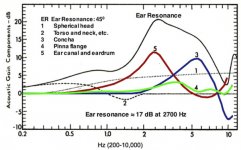For approximately how long has this been the case?
Very long, long enough that we had major discussion of this when I was in automotive audio, and I got out of that some 20 years ago.
Also of interest was when I expressed my opinion that movie soundtracks seem to always sound better than CD's. My friend said "Sure, no one who mixes movies ever cared about how it would sound in a car!" That made so much sense to me.
Earl, you might also consider the difference in budget between movie mixes and the average pop song mix, you know the logarithmic scale..Very long, long enough that we had major discussion of this when I was in automotive audio, and I got out of that some 20 years ago.
Also of interest was when I expressed my opinion that movie soundtracks seem to always sound better than CD's. My friend said "Sure, no one who mixes movies ever cared about how it would sound in a car!" That made so much sense to me.
Now it’s earbuds and headphones.
Earbuds are better than loudspeakers. More exactly the balanced armature type.
Over the ear headphones act more like traditional loudspeakers.
Earbuds are better than loudspeakers. More exactly the balanced armature type.
but they have worse measurable characteristics (including distortions) than the simple dynamic type microdrivers
examples at: HeadRoom Headphone Graph Comparison Tool
It is hard to find good headphones. When I just graduated from university, my main listening was done with headphones, the open air kind seemed to be best to me. Now, it is even more difficult to find something regardless of price. The Apple EarPods were of acceptable value to me, adding some impedance interfacing improves performance, but the detail is still lacking due to the diaphragm material.
Headphones are not meant to be flat. If they were flat, they would sound horrible. There is plenty of info on this subject, easy to find.
The responses shown differ that much that it is hard to believe that more than a few percent of them could sound like something resembling "neutral".
Regards
Charles
Setups: Joachim Gerhard
Joachim presented his hat-phone with real fullrange speakers playing. This had really a powerful sound. Please note, you must have an appropriate equalisation for the fullrange speakers.
http://www.tnt-audio.com/jpg/etf15/etf15_21.jpg
[Show] European Triode Festival 2015 Report
but they have worse measurable characteristics (including distortions) than the simple dynamic type microdrivers
examples at: HeadRoom Headphone Graph Comparison Tool
Our outer ear does some serious eq'ing (+10-15dB!) of sound before it reaches the ear drum.
This is largely bypassed when using headphones consequently 'phones with a flat measured response do not sound anything like flat.
However every manufacturer of 'phones uses a different model of pinnae to design theirs. The trick is to find the manufacturer whose pinnae model most closely resembles yours. For me that manufacturer is Beyer, others get better results with Sennheiser, Audio Technica or others.
The only time headphones should have a flat FR is when playing dummy head recordings which record the pinnae eq.
Auricle (anatomy - Wikipedia)
Scroll down to 'Function'.
I really like Shure E2c.
Reference earphones
as a reference, because for normal use I found sticking anything into my ears too uncomfortable.
Reference earphones
as a reference, because for normal use I found sticking anything into my ears too uncomfortable.
Our outer ear does some serious eq'ing (+10-15dB!) of sound before it reaches the ear drum.
This is largely bypassed when using headphones consequently 'phones with a flat measured response do not sound anything like flat...
To put it in a picture to better compare against measured headphone/IEM responses:
Attachments
I've done a lot of in-ear headphone measurements and looked at the theory of the EQ somewhat. So has Sean Olive at JBL. We both have concluded that the common idea of free-field equalization, which are the curves shown above, is not correct. What one has to remember is that that data was taken with an open ear canal. When the ear is occluded the curves would be completely different. So its been a mystery for a long time trying to figure out what curve does sound best. As I recall, Sean came up with the same thing that I did, which is basically that flat response still sounds best. That would not be true if we were trying to EQ to externalize the sound, i.e. remove the in-the-head sound, but if what one wants is just a satisfying sound then basic flat works very well.
FYI, by far my favorite headphones also measure the flattest, and are very cheap. They are the Visang VS-R02 available from Amazon. They are $40 and work much better IMO than a $300 set that I tested and still have.
FYI, by far my favorite headphones also measure the flattest, and are very cheap. They are the Visang VS-R02 available from Amazon. They are $40 and work much better IMO than a $300 set that I tested and still have.
- Home
- Loudspeakers
- Multi-Way
- Who makes the lowest distortion speaker drivers
